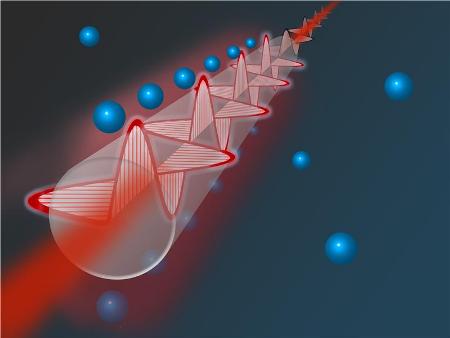A research team led by Professor Arno Rauschenbeutel Vienna Center for Quantum Science and Technology, in partnership with the researchers at the Johannes Gutenberg University has developed an ultrasensitive method by controllably coupling single atoms to light within ultra-thin fiber glass having a thickness of 500 nm, paving the way to develop detectors that are capable of sensing ultra-trace amounts of materials.
 The light wave in the glass fiber sticks out and touches the atoms trapped above and below the glass fiber.
The light wave in the glass fiber sticks out and touches the atoms trapped above and below the glass fiber.
In the novel method, specially created light waves were made to intermingle with fewer numbers of atoms. The thickness of the ultrathin glass fibers is smaller than the visible light wavelength, which makes the light waves to contact atoms that are situated remotely, but nearby the glass fiber, said Rauschenbeutel. At first, the researchers trapped the atoms by aligning them on top and bottom of the glass fiber and then passed the light wave via the glass fiber wherein the light wave is changed by every single atom it crosses, he said. By accurately measuring the modifications experienced by the light waves, the count of atoms entrapped close to the fiber can be detected, he explained.
Rauschenbeutel further said that the light gets decelerated by the atoms nearby the glass fiber very mildly. When the light wave propagates accurately downwards and upwards along the direction of the atoms, it is relocated by a small amount, he said. Whereas, another light wave that propagates in the opposite direction is not at all decelerated, as it does not contact any atoms, he added. As of now, the method can sense the presence of 10 or 20 atoms, but by decreasing the distance between the glass fiber and the atoms it is possible to determine the presence of single atoms, he explained.
Besides being capable of developing next-generation detectors, the novel glass fiber measuring technique can also be used for fundamental quantum physical research. Rauschenbeutel commented that the ultrathin glass fiber can be used to measure quantum states without demolishing them. The atoms nearby the glass fiber are capable of controlling the plane wherein the light wave swings.